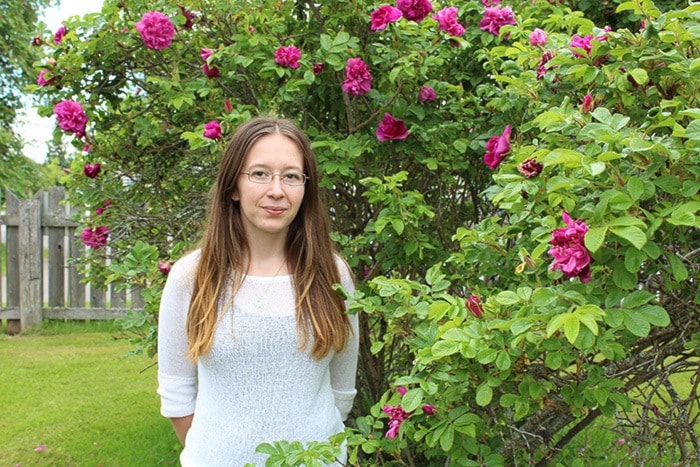By Kelsey Wiebe
'Always plant your flowers first,’ Eva Haugland used to tell her children, one of whom became Mamie Kerby. Mamie and her daughter Norma Kerby took this advice to heart when they established Heritage Park Museum in the early 1980s.
Norma, a professor of biology, ensured that a Heritage Garden was included in the preservation of log buildings and artifacts coordinated by the Terrace Regional Museum Society. Norma worked with Floyd Frank and other old-timers to secure plants whose provenance, or story, could be traced into the early settlement days.
These plants include rhubarb that came to the Terrace area by sternwheeler from Port Essington before our town had been named. Over the arch at the front gate, we have a honeysuckle from Tom and Eliza Thornhill’s garden between the two bridges that dates back to the 1890s. One of our most showy plants is the Lindstrom rose, which was bred by Emma Bateman Lindstrom at Bateman’s landing near the Zymacord River in the early 1900s. The rose is thought to be a hybrid between an English rose and a wild rose native to our area. It blooms all summer long, and is fragrant and bushy.
When I came on board, four-and-a-half years ago, Norma’s garden had been completely dug up. The irises and lilies had spread in the main garden plot, overtaking all of the less territorial flowers. The museum had no choice but to dig up the garden, saving and tagging what remained.
Norma recommended that we install aluminum flashing around each plant so that we could better control the wildness of the garden, and keep the more invasive plants in check. Volunteer Terrace provided two stellar volunteers, Mark Zhang and David Scherer, who began this project. Cathy Jackson from Spotted Horse Nursery donated bedding plants to fill the holes until our plants grew back.
In the midst of this community support, I tried to keep up with garden weeding and watering, but it was clear immediately that the garden was too large of a task for anyone to do from the side of a desk.
That winter, we applied for summer student funding for a garden coordinator to maintain, expand, and research the garden. We were lucky enough to receive funding from Young Canada Works in Heritage Organizations. We were truly lucky, though, when we hired Terra Nord for the job.
Over the past three summers, Terra transformed our garden from a basically bare plot into a thriving, beautiful complement to the museum buildings. She secured donations from all over the community, ranging from a snowball bush from Norma Kerby to banana potatoes from the Froese family, via Ewa Luby and Colleen Froese. After researching the provenance and care of these plants, Terra integrated them into the existing garden. She added compost, manure, and dolomitic lime to the soil, thinned irises and lilies, and researched organic solutions for pests.
To help us be more sustainable, Terra built the museum a compost bin. We have added the coffee grounds and fruit rinds from seniors’ teas all summer, and are on track to have lots of rich loamy soil to add to garden beds.
Along the same lines, Terra converted the old cedar from our porch into planter boxes in which our rhubarb and potatoes have thrived. She distributed hundreds of Skeena Wonder Strawberry runners, and networked with gardeners across Terrace.
In addition to weeding and expanding our understanding of each plant’s history and needs, Terra developed garden-related programming, including children’s workshops on bees, gardening, and compost, in the hopes of creating a new generation of gardeners.
One of Terra’s most lasting impacts is a comprehensive database of plant origin and a garden care plan to ensure that, in future years, the garden continues to be historically meaningful and properly cared for.
Thanks to the Kerbys, the community, and Terra, the flowers have not been forgotten! Terrace gardeners are welcome to dig up some of our plants—we are happy to share!
